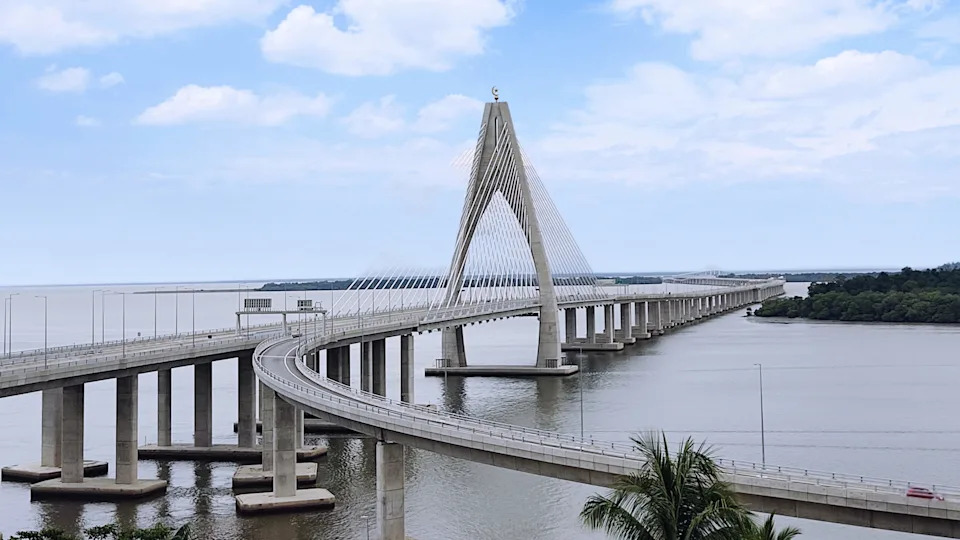Southeast Asia’s longest bridge is causing concern among conservationists and residents alike for its noticeable impacts on wildlife and local biodiversity.
What’s happening?
The Sultan Haji Omar ‘Ali Saifuddien Bridge is a massive 16-mile bridge in Brunei, which connects the country’s forested Temburong region with its urban capital. Opened in March 2020, the bridge promised to increase access and economic opportunities for local communities. But the structure has also reportedly caused a troubling rise in the hunting of native species.
Traditionally, hunting in Temburong was largely done by Indigenous communities for subsistence. These practices, rooted in traditional knowledge, placed relatively little strain on local wildlife. However, a recent study found that the bridge has made the region far more accessible, reducing travel time to urban markets and opening the door to recreational hunting and hunting for profit.
The forested region is home to a variety of protected species and rich biodiversity, including the critically endangered Sunda pangolin. Pangolins are protected under the Convention on International Trade in Endangered Species international trade regulations, yet they lack explicit protections under Brunei’s national laws.
Locals told Mongabay that while pangolins are difficult to find, they are quickly targeted when spotted, with some hunters even crossing borders to sell them abroad at high prices.
“Not introducing robust legislation for pangolin conservation can have serious impacts on its sustainable protection and conservation,” a conservationist told Mongabay.
Notably, the bridge passes through the Labu Forest Reserve, which is a protected stretch of dense rainforest. Residents nearby reported noticing “unusual wildlife movements and migrations” since the bridge opened, and experts say it’s a signal of the far-reaching environmental disruption that infrastructure projects can cause.
Why is this bridge’s impact on wildlife and biodiversity important?
Brunei’s massive bridge — and its unintended consequences — highlights the need to balance rural development with protecting the ecosystems that people and the planet depend on. While infrastructure projects can bring economic opportunities and improve ease of living, they also risk eroding natural wildlife buffers and disrupting fragile ecosystems.
By cutting through protected rainforest, the bridge has not only altered wildlife movement but also made remote ecosystems far more accessible to hunters. This puts added pressure on already vulnerable species — such as the pangolin — while weakening the delicate balance of biodiversity that helps keep forests healthy.
Healthy forests, like those in Temburong, play a crucial role in absorbing carbon and regulating the climate, making them vital to protect. Not only that, but increased hunting, habitat disruption, and weak wildlife protections threaten animal conservation efforts and weaken rainforest resilience as a whole.
|
Do you think your city has good air quality? Click your choice to see results and speak your mind. |
What’s being done about the bridge’s impact on wildlife and biodiversity?
Locals highlighted that finding a balance between tradition, conservation, and economic growth will be crucial as Brunei moves forward with development. Scientists agree, emphasizing the need for context-specific conservation and management strategies whenever access to remote areas increases. This includes looking at which species are most at risk and making sure they are protected.
Required actions could include encouraging more sustainable local hunting practices, laws regulating or preventing hunting, and more.
Brunei has taken some steps in this direction. Since 1989, the country’s National Forest Policy has guided efforts to conserve and manage large areas of forest. As part of the policy, the government has set a target to have at least 55% of its land area under forest reserve protection, which is expected to aid in wildlife protection and local biodiversity.
That said, no plans are underway to specifically address the impacts of the bridge on wildlife and the environment.
Join our free newsletter for good news and useful tips, and don’t miss this cool list of easy ways to help yourself while helping the planet.
Yahoo News – Latest News & Headlines
Read the full article .


